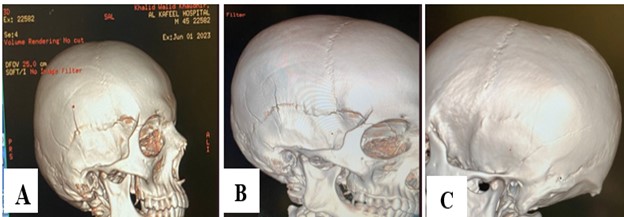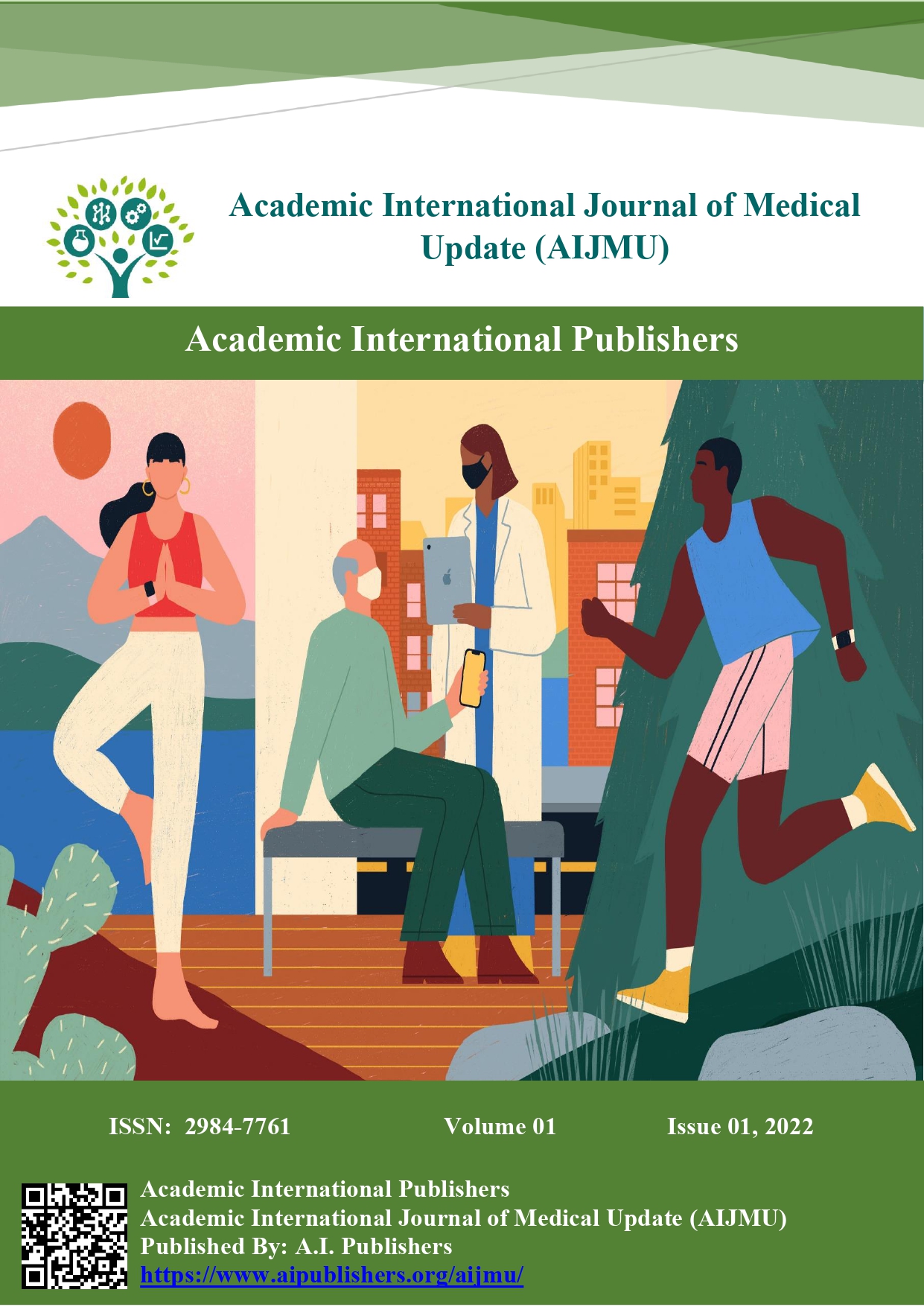Assessing the Role of Neurosurgical Consultation in The Treatment of Isolated Linear Pediatric Skull Fractures
DOI:
https://doi.org/10.59675/U223Abstract
Objective: Head injuries represent a significant issue for emergency pediatric care. Most brain injuries are rather minor. The majority of individuals experience positive results even when computed tomography (CT) reveals abnormalities. Our goal was to assess the Glasgow Coma Scale (GCS) and clinical course of pediatric patients with head trauma. Score of 15, in which aberrant findings on cranial CT were observed, in order to ascertain the influence of radiographic characteristics on the necessity of hospitalization and the course of clinical care. Methods: Patients under the age of five to thirteen who had inaccessible mild head injuries, GCS scores of fifteen, aberrant CT results, and who were admitted to the emergency room between July 2021 and August 2023 were retrospectively examined.
Results: The study involved ninety patients. There were 55 patients (66%) who were male, and (5–13 years). Hospitalization was necessary for eighty-six (85%) of the patients, with a median stay of one day (one to five days). Repeat CT was performed on sixty-eight (70%) of the patients, and radiographic progression was seen in 15 (25%) of the patients. Two patients (3%), out of the ten patients, required surgery for their subdural or epidural hematomas. No radiological or clinical deterioration was observed in patients with a single skull fracture or subarachnoid hemorrhage.
Conclusion, even when CT scans reveal abnormalities, surgery may not always be necessary for individuals with head injuries aged 5 to 13 who take a GCS score of 10. Patients with isolated skull fractures before subarachnoid hemorrhages, in example, may not always need to be hospitalized. To validate the results of this investigation, a validation study is required.
Downloads
References
Taylor CA, Bell JM, Breiding MJ, Xu L: Traumatic brain injury-related emergency department visits, hospitalizations, and deaths - united states, 2007 and 2013. MMWR Surveill Summ 66 : 1-16, 2017 DOI: https://doi.org/10.15585/mmwr.ss6609a1
Möller TB, Reif E: Pocket Atlas of Radiographic Positioning: Including Positioning for Conventional Angiography, CT, and MRI. Noida : Thieme, 2008
Le TH, Gean AD: Neuroimaging of traumatic brain injury. Mt Sinai J Med 76 : 145-162, 2009 DOI: https://doi.org/10.1002/msj.20102
Amyot F, Arciniegas DB, Brazaitis MP, Curley KC, Diaz-Arrastia R, Gandjbakhche A, et al. : A review of the effectiveness of neuroimaging modalities for the detection of traumatic brain injury. J Neurotrauma 32 : 1693-1721, 2015 DOI: https://doi.org/10.1089/neu.2013.3306
Wintermark M, Sanelli PC, Anzai Y, Tsiouris AJ, Whitlow CT; ACR Head Injury Institute, et al.: Imaging evidence and recommendations for traumatic brain injury: conventional neuroimaging techniques. J Am Coll Radiol 12 : e1-e14, 2015 DOI: https://doi.org/10.1016/j.jacr.2014.10.014
Simon B, Letourneau P, Vitorino E, McCall J. Pediatric minor head trauma: indications for computed tomographic scanning revisited. J Trauma. 2001;51:231–7. https://doi. org/10.1097/00005373-200108000-00004. DOI: https://doi.org/10.1097/00005373-200108000-00004
Boran BO, Boran P, Barut N, Akgun C, Celikoglu E, Bozbuga M. Evaluation of mild head injury in a pediatric population. Pediatr Neurosurg. 2006;42:203–7. https:// doi.org/10.1159/000092355. DOI: https://doi.org/10.1159/000092355
Vos PE, Alekseenko Y, Battistin L, Ehler E, Gerstenbrand F, Muresanu DF, et al. Mild traumatic brain injury. Eur J Neurol. 2012;19(2):191–8. https://doi.org/10.1111/j. 1468-1331.2011.03581. DOI: https://doi.org/10.1111/j.1468-1331.2011.03581.x
Mannix R, Monuteaux MC, Schutzmann SA, Meehan 3rd WP, Nigrovic LE, Neuman MI. Isolated skull fractures: trends in management in US pediatric emergency departments. Ann Emerg Med. 2013;62:327–31. https://doi.org/10.1016/j. annemergmed.2013.02.027.
Bressan S, Marchetto L, Lyons TW, Monuteaux MC, Freedman SB, Dalt LD, et al. A systematic review and meta-analysis of the management and outcomes of isolated skull fractures in children. Ann Emerg Med. 2018;71. https://doi.org/10.1016/j. annemergmed.2017.10.014 714–24.e2. DOI: https://doi.org/10.1016/j.annemergmed.2017.10.014
Holsti M, Kadish HA, Sill BL, Firth SD, Nelson DS. Pediatric closed head injuries treated in an observation unit. Pediatr Emerg Care. 2005;21:639–44. https://doi. org/10.1097/01.pec.0000181426.25342.a9. DOI: https://doi.org/10.1097/01.pec.0000181426.25342.a9
Lefort R, Hunter JV, Cruz AT, Caviness AC, Luerssen TG, Adekunle-Ojo. Utility of emergency department observation units for neurologically intact children with head CT abnormalities secondary to acute closed head injury. Pediatr Emerg Care 2017;33:161–5. doi:https://doi.org/10.1097/pec.0000000000000863. DOI: https://doi.org/10.1097/PEC.0000000000000863
Schutzman SA, Barnes P, Duhaime AC, Greenes D, Homer C, Jaffe D, et al. Evaluation and management of children younger than two years old with apparently minor head trauma: proposed guidelines. Pediatrics. 2001 May;107(5):983–93. DOI: https://doi.org/10.1542/peds.107.5.983
Schutzman SA, Greenes DS. Pediatric minor head trauma. Ann Emerg Med. 2001 Jan; 37(1):65–74. DOI: https://doi.org/10.1067/mem.2001.109440
Mannix R, Monuteaux MC, Schutzman SA, Meehan WP 3rd, Nigrovic LE, Neuman MI. Isolated skull fractures: trends in management in US pediatric emergency departments. Ann Emerg Med. 2013 Oct;62(4):327– 31. DOI: https://doi.org/10.1016/j.annemergmed.2013.02.027
Arrey EN, Kerr ML, Fletcher S, Cox CS Jr, Sandberg DI. Linear nondisplaced skull fractures in children: who should be observed or admitted? J Neurosurg Pediatr. 2015 Dec; 16(6):703–8. DOI: https://doi.org/10.3171/2015.4.PEDS1545
Mackel CE, Morel BC, Winer JL, Park HG, Sweeney M, Heller RS, et al.: Secondary overtriage of pediatric neurosurgical trauma at a Level I pediatric trauma center. J Neurosurg Pediatr 2018 Oct;22(4):375–383.
Beyaz S, Açıcı K, Sümer E : Femoral neck fracture detection in X-ray images using deep learning and genetic algorithm approaches. Jt Dis Relat Surg 31 : 175-183, 2020 DOI: https://doi.org/10.5606/ehc.2020.72163
Chung SW, Han SS, Lee JW, Oh KS, Kim NR, Yoon JP, et al. : Automated detection and classification of the proximal humerus fracture by using deep learning algorithm. Acta orthop 89 : 468-473, 2018 DOI: https://doi.org/10.1080/17453674.2018.1453714
Krogue JD, Cheng KV, Hwang KM, Toogood P, Meinberg EG, Geiger EJ, et al. : Automatic hip fracture identification and functional subclassification with deep learning. Radiol Artif Intell 2 : e190023, 202 DOI: https://doi.org/10.1148/ryai.2020190023
Ozkaya E, Topal FE, Bulut T, Gursoy M, Ozuysal M, Karakaya Z : Evaluation of an artificial intelligence system for diagnosing scaphoid fracture on direct radiography. Eur J Trauma Emerg Surg 48 : 585-592, 2020 DOI: https://doi.org/10.1007/s00068-020-01468-0
Neurosurg Pediatr 2014;14(2):205–211. 14 Addioui A, Saint-Vil D, Crevier L, Beaudin M. Management of skull fractures in children less than 1 year of age. J Pediatr Surg. 2016 Jul; 51(7):1146–50.
Greenberg JK, Stoev IT, Park TS, Smyth MD, Leonard JR, Leonard JC, et al. Management of children with mild traumatic brain injury and intracranial hemorrhage. J Trauma Acute Care Surg. 2014 Apr;76(4):1089–95. DOI: https://doi.org/10.1097/TA.0000000000000155
Powell EC, Atabaki SM, Wootton-Gorges S, Wisner D, Mahajan P, Glass T, et al. Isolated linear skull fractures in children with blunt head trauma. Pediatrics. 2015 Apr; 135(4):e851–7.
Mackel CE, Morel BC, Winer JL, Park HG, Sweeney M, Heller RS, et al.: Secondary overtriage of pediatric neurosurgical trauma at a Level I pediatric trauma center. J Neurosurg Pediatr 2018 Oct;22(4):375–383. DOI: https://doi.org/10.3171/2018.5.PEDS182
Blackwood BP, Bean JF, Sadecki-Lund C, Helenowski IB, Kabre R, Hunter CJ. Observation for isolated traumatic skull fractures in the pediatric population: unnecessary and costly. J Pediatr Surg. 2016 Apr;51(4):654–8 DOI: https://doi.org/10.1016/j.jpedsurg.2015.08.064
Addioui A, Saint-Vil D, Crevier L, Beaudin M. Management of skull fractures in children less than 1 year of age. J Pediatr Surg. 2016 Jul; 51(7):1146–50. DOI: https://doi.org/10.1016/j.jpedsurg.2016.01.007
Tavor O, Boddu S, Kulkarni AV. Presenting characteristics of children who required neurosurgical intervention for head injury. Childs Nerv Syst. 2016 May;32(5):827–31. DOI: https://doi.org/10.1007/s00381-016-3030-5
Kuppermann N, Holmes JF, Dayan PS, Hoyle JD Jr, Atabaki SM, Holubkov R, et al.; Pediatric Emergency Care Applied Research Network (PECARN). Identification of children at very low risk of clinically-important brain injuries after head trauma: a prospective cohort study. Lancet. 2009 Oct;374(9696):1160–70.
Bonfield CM, Naran S, Adetayo OA, Pollack IF, Losee JE: Pediatric skull fractures: the need for surgical intervention, characteristics, complications, and outcomes. J Neurosurg Pediatr 2014;14(2):205–211. DOI: https://doi.org/10.3171/2014.5.PEDS13414
Vedantam A, Hansen D, Briceno V, Moreno A, Ryan SL, Jea A: Interhospital transfer of pediatric neurosurgical patients. J Neurosurg Pediatr 2016;18(5):638–643 DOI: https://doi.org/10.3171/2016.5.PEDS16155
White IK, Pestereva E, Shaikh KA, Fulkerson DH. Transfer of children with isolated linear skull fractures: is it worth the cost? J Neurosurg Pediatr. 2016 May;17(5):602–6 DOI: https://doi.org/10.3171/2015.9.PEDS15352
Kim JW, Tiyyagura G, Langhan M. A qualitative analysis of general emergency medicine providers’ perceptions on pediatric emergency telemedicine. Pediatr Emerg Care. 2017 Feb. DOI: 10.1097/PEC.0000000000001067; epub ahead of print. DOI: https://doi.org/10.1097/PEC.0000000000001067
Ray KN, Felmet KA, Hamilton MF, Kuza CC, Saladino RA, Schultz BR, et al. Clinician Attitudes Toward Adoption of Pediatric Emergency Telemedicine in Rural Hospitals. Pediatr Emerg Care. 2017 Apr;33(4):250–7. DOI: https://doi.org/10.1097/PEC.0000000000000583
Kahn EN, La Marca F, Mazzola CA. Neurosurgery and Telemedicine in the United States: Assessment of the Risks and Opportunities. World Neurosurg. 2016 May;89:133–8 DOI: https://doi.org/10.1016/j.wneu.2016.01.075
Powell EC, Atabaki SM, Wootton-Gorges S, Wisner D, Mahajan P, Glass T, et al. Isolated linear skull fractures in children with blunt head trauma. Pediatrics. 2015 Apr; 135(4):e851–7 DOI: https://doi.org/10.1542/peds.2014-2858

Downloads
Published
Issue
Section
License
Copyright (c) 2024 Academic International Journal of Medical Update

This work is licensed under a Creative Commons Attribution 4.0 International License.


